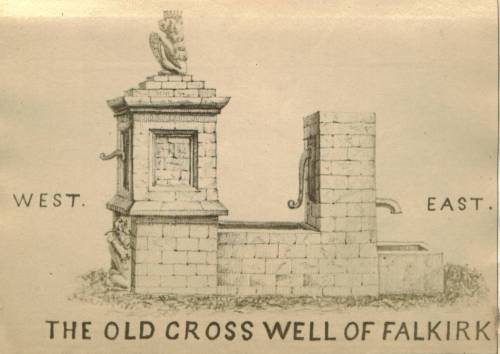
When King James IV made Falkirk a burgh of barony in 1600 one of the first signs of the new status would have been a Mercat Cross erected at the foot of the town steeple. From then on the area of the cross became the centre of all important activities from weekly markets to public floggings and hangings. The town tron or weighing machine stood nearby as well as the stocks and gallows, but it was not until the last decades of the 17th century that the first cross well appeared.
Following a drought in the town in 1682 when both East and West Burns appear to have dried up a new water supply was brought in wooden pipes joined by lead sleeves from the Callendar lands to the south of the town to the High Street at the Cross. This was done by the Livingston family as a gift to the people of the town.
The first stone well-head carried the coat of arms of Alexander Livingston who assumed the title of 2nd Earl of Callendar in 1681 but there is a long established tradition that the water supply was inspired by his father James the first Earl and that it was he who was present when the first water was drawn from the cross well. We are told that James, who was a famous soldier and had been a man of considerable importance in Scotland, gathered all his feuars in the town round about the cross and,
After thanking them for the gallantry with which they had fought beside him, and reminding them of the many fields through which their fathers had followed his; having filled a bicker from the pure well stream, which was poured from the mouth of a sculptured lion, the grey-haired baron stood up in his stirrups and drank off the quaich, ‘To the wives and the bairns o’ Fa’kirk’ giving them the well and all its fountains in a present forever.
And with this present of course came a new nickname for the inhabitants for we have been the ‘bairns’ ever since.
By the beginning of the 18th century the well-head was in a poor condition and in 1817, three after the new steeple was completed, the burgh authorities decided to replace it with the existing round sandstone well which has just returned from its eleven year exile in the repairers yard.
With the loss of the Mercat Cross in 1715 after the failed Jacobite rising and the disappearance of gallows, stocks and tron, the Cross Well stands as an powerful link with Falkirk’s colourful past and a symbol of its important place as a major trading centre.
Ian Scott (2005)
For further information see this article about The Cross Well in Historical Objects section.


